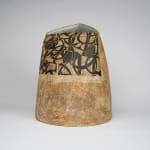WADA Morihiro
H23.8 x W20.8 x D19cm
Further images
-
(View a larger image of thumbnail 1
)

-
(View a larger image of thumbnail 2
)

-
(View a larger image of thumbnail 3
)

-
(View a larger image of thumbnail 4
)

-
(View a larger image of thumbnail 5
)

-
(View a larger image of thumbnail 6
)

-
(View a larger image of thumbnail 7
)

-
(View a larger image of thumbnail 8
)

-
(View a larger image of thumbnail 9
)

-
(View a larger image of thumbnail 10
)

-
(View a larger image of thumbnail 11
)

-
(View a larger image of thumbnail 12
)

-
(View a larger image of thumbnail 13
)

-
(View a larger image of thumbnail 14
)

-
(View a larger image of thumbnail 15
)

-
(View a larger image of thumbnail 16
)

Wada Morihiro followed in the footsteps of ceramic genius Kamoda Shoji (1933-1983) by opening his own studio in Kasama city after finishing graduate work at Kyoto Art University, where he had studied with renowned artist Tomimoto Kenkichi (1886-1963). Born in 1944, Wada began exhibiting at some of Japan’s best contemporary ceramics galleries as early as 1979, when we was honored with a solo exhibition at Minami Aoyama Green gallery. I remember being directed to his work by the late Sydney Cardozo, a great collector and connoisseur. From this early success, Wada soared in reputation and fame, enjoying numerous solo exhibitions at prime venues, including the galleries at various Takashimaya department stores. International acclaim soon followed. He won numerous prizes, including a gold prize in Faenza, Italy in 1980, and was widely collected by both private collectors and museums. It was my privilege to meet Wada. We talked about China, my China, and I later learned that he had a particular fascination with that country. I wish we had had an opportunity to talk about much more. Wada was a gentile and modest person. His work is vigorous, intriguing, and ever changing. Now, though his voice is silenced, Wada continues to speak to us through his art.
Under Tomimodo Kenkichi’s guidance at Kyoto Art University, all students were supposed to learn from and recreate nature in their work. In Wada’s hands, nature became abstract as plants, animals, and natural forces became symbols and decorative elements, often combining into intricate abstract pattern. These patterns often rise from the repetition of abstracted natural form, becoming a unique expression of Wada’s particular view of the natural world. He used natural materials as much as possible, including different forms of clay, sand, and slip. He experimented with various colored natural clays that produce a variety of colors after high firing, including grey-green, dark auburn, purple, and navy. These Vessels he inlaid with white slip patterning, allowing the colorful clay to show through the inlaid lines in ever more complicated and intricate processes.
This piece exemplifies artist’s masterful patterning technique, which requires a lengthy process of building, inlaying, scraping, and glazing. The patterning recalls shards of ice, mountain peaks, cresting waves and billowing clouds, all at the same time. These forms arise from Wada’s own abstractions, rendering them completely unique and personal. I learned from Kiki Smith that the way to discern the real talent of an artist is to look to the way that an opening of a vessel is finished. This form is organic and natural, as if it grew up from the base. Every detail is sought after and highly considered, and many collectors have taken notice of this fact.
Wada’s work can be found at the Minneapolis Institute of Art; the Mint Museum, Charlotte, North Carolina; the New Orleans Museum of Art; the Newark Museum of Art, New Jersey; the Philadelphia Museum of Art; Faenza International Museum of Ceramics, Italy; Musée National de Céramique, Sèvres, France; Musée National de la Porcelaine Adrien-Dubouché, Limoges, France; the Victoria and Albert Museum, London; Musée Tomo, Tokyo; Kure Municipal Museum of Art, Hiroshima; Ogawa Museum of Art, Tokyo; Ibaraki Museum of Modern Art; Tokyo National Museum of Art; and the Tochigi Prefectural Museum of Fine Arts, as well as in numerous private collections.















